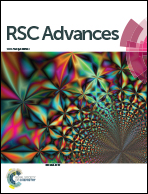The influence of Si(iv) on the reactivity of [![[triple bond, length as m-dash]](https://www.rsc.org/images/entities/char_e002.gif) Fe(iii)]/[
Fe(iii)]/[![[triple bond, length as m-dash]](https://www.rsc.org/images/entities/char_e002.gif) Fe(ii)] couples for 2-nitrophenol reduction in γ-Al2O3 suspensions†
Fe(ii)] couples for 2-nitrophenol reduction in γ-Al2O3 suspensions†
Abstract
In a natural environment, Fe(II) adsorbed onto the surfaces of natural particles to form various surface complex species can influence the transformation of contaminants. The reductive reactivity of the [![[triple bond, length as m-dash]](https://www.rsc.org/images/entities/char_e002.gif) Fe(III)]/[
Fe(III)]/[![[triple bond, length as m-dash]](https://www.rsc.org/images/entities/char_e002.gif) Fe(II)] couples are close correlated with the surrounding conditions. In this study, we investigated the effects of Si(IV) on the reductive reactivity of [
Fe(II)] couples are close correlated with the surrounding conditions. In this study, we investigated the effects of Si(IV) on the reductive reactivity of [![[triple bond, length as m-dash]](https://www.rsc.org/images/entities/char_e002.gif) Fe(III)]/[
Fe(III)]/[![[triple bond, length as m-dash]](https://www.rsc.org/images/entities/char_e002.gif) Fe(II)] couples adsorbed onto γ-Al2O3. Experiments were conducted under different conditions to investigate the effects of Si(IV) on the reactivity of [
Fe(II)] couples adsorbed onto γ-Al2O3. Experiments were conducted under different conditions to investigate the effects of Si(IV) on the reactivity of [![[triple bond, length as m-dash]](https://www.rsc.org/images/entities/char_e002.gif) Fe(III)]/[
Fe(III)]/[![[triple bond, length as m-dash]](https://www.rsc.org/images/entities/char_e002.gif) Fe(II)] couples for 2-nitrophenol (2-NP, selected as the model pollutant) reduction in γ-Al2O3 suspensions. Kinetics results revealed that chemical adsorption is the rate limiting step in Fe(II) and Si(IV) adsorption processes and the reduction of 2-NP is an endothermic reaction. The linear correlations between the reduced peak oxidation potential (Ep) (versus SCE) and 2-NP reduction rate (ln k), and between the adsorbed Fe(II) density (ρFe(II)) and ln k, illustrated that Ep and ρFe(II) are two key factors in the inhibiting effects of Si(IV) on the reductive reactivity of Fe(III)/Fe(II) couples on γ-Al2O3. The results of Fe K-edge X-ray absorption spectroscopy revealed that the increase of Si(IV) concentration resulted in the gradual change in the composition of the adsorbed Fe species from pure
Fe(II)] couples for 2-nitrophenol (2-NP, selected as the model pollutant) reduction in γ-Al2O3 suspensions. Kinetics results revealed that chemical adsorption is the rate limiting step in Fe(II) and Si(IV) adsorption processes and the reduction of 2-NP is an endothermic reaction. The linear correlations between the reduced peak oxidation potential (Ep) (versus SCE) and 2-NP reduction rate (ln k), and between the adsorbed Fe(II) density (ρFe(II)) and ln k, illustrated that Ep and ρFe(II) are two key factors in the inhibiting effects of Si(IV) on the reductive reactivity of Fe(III)/Fe(II) couples on γ-Al2O3. The results of Fe K-edge X-ray absorption spectroscopy revealed that the increase of Si(IV) concentration resulted in the gradual change in the composition of the adsorbed Fe species from pure ![[triple bond, length as m-dash]](https://www.rsc.org/images/entities/char_e002.gif) AlOFe+ (γ-Al2O3 surface-bound Fe(II) species with higher reductive reactivity) to a mixture of
AlOFe+ (γ-Al2O3 surface-bound Fe(II) species with higher reductive reactivity) to a mixture of ![[triple bond, length as m-dash]](https://www.rsc.org/images/entities/char_e002.gif) AlOFe+ and
AlOFe+ and ![[triple bond, length as m-dash]](https://www.rsc.org/images/entities/char_e002.gif) SiOFe+ (SiO2 surface-bound Fe(II) species with lower reductive reactivity), leading to the decrease in ρFe(II), the positive shift in Ep, the increase in activation energy (Ea), and consequently the decrease in the reduction rate (ln k) of 2-NP.
SiOFe+ (SiO2 surface-bound Fe(II) species with lower reductive reactivity), leading to the decrease in ρFe(II), the positive shift in Ep, the increase in activation energy (Ea), and consequently the decrease in the reduction rate (ln k) of 2-NP.
![Graphical abstract: The influence of Si(iv) on the reactivity of [ [[triple bond, length as m-dash]] Fe(iii)]/[ [[triple bond, length as m-dash]] Fe(ii)] couples for 2-nitrophenol reduction in γ-Al2O3 suspensions](/en/Image/Get?imageInfo.ImageType=GA&imageInfo.ImageIdentifier.ManuscriptID=C7RA13201H&imageInfo.ImageIdentifier.Year=2018)


 Please wait while we load your content...
Please wait while we load your content...
![[triple bond, length as m-dash]](https://www.rsc.org/images/entities/h2_char_e002.gif) Fe(III)]/[
Fe(III)]/[